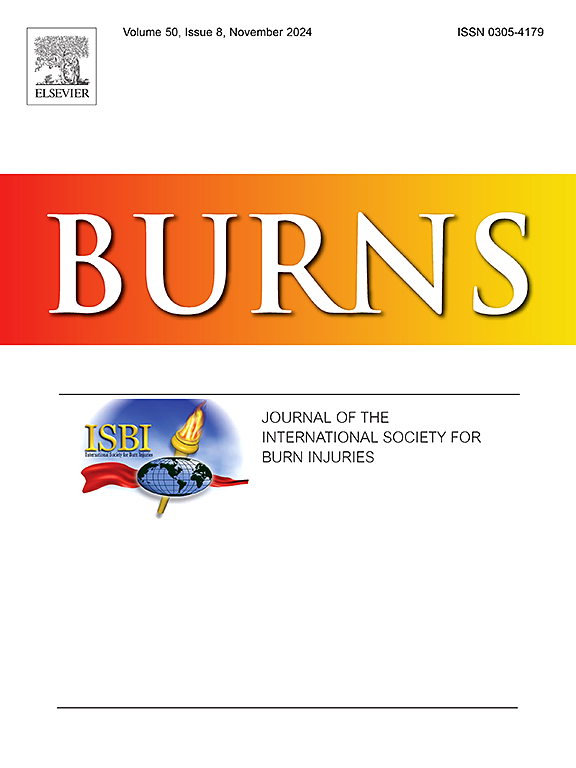Design and validation of a preclinical model for oral commissure and lower eyelid thermal injury
IF 3.2
3区 医学
Q2 CRITICAL CARE MEDICINE
引用次数: 0
Abstract
Introduction
Oral commissure stenosis and lower eyelid ectropion from burns are functionally impairing and challenging to treat. Evaluation of various treatment modalities is limited by a lack of preclinical models. Described is a method for inducing controlled, titratable oral commissure and lower eyelid burns in swine for future treatment research.
Methods
Burn wounds 3 cm in diameter were applied to the lower eyelid and oral commissure of seven anesthetized Yorkshire swine for 10, 15, 20, or 30 s at 100 °C with a custom designed thermocouple-controlled burn device and observed for 3, 30, or 90 days. Tissue underwent laser speckle imaging (LSI) to assess vascular perfusion and histologic analysis after harvest. Statistical comparisons were calculated using Wilcoxon rank-sum tests.
Results
Subdermal extension was noted in oral commissure and lower eyelid burns with contact time of 20 s or greater. Wound area progressively contracted from post-operative day (POD) 0 to 90 in both sites, but this was not statistically significant based on contact time or burn site (p > 0.20). Burns of 20–30 s demonstrated increased neutrophil influx for oral commissure injuries (p < 0.01) and leukocyte and macrophage influx for lower eyelid injuries (p = 0.02). Degree of vascular congestion increased with 20–30 second burns in both the oral commissure (p = 0.015) and lower eyelid (p = 0.04). Normalized LSI readings showed increased speckle size in both oral commissure (4.0-fold increase, p < 0.01) and lower eyelid (3.2-fold increase, p < 0.01) burns on POD 90 compared to pre-injury. No change in oral or ocular function was noted in any of the groups (p = 0.96).
Conclusion
Oral commissure and lower eyelid burns create scars which may be modified by burn duration. This model may evaluate a therapeutic’s ability to limit functional impairment from burns.
设计并验证口腔黏膜和下眼睑热损伤临床前模型
介绍:烧伤造成的口腔会厌狭窄和下眼睑外翻会影响功能,而且治疗难度很大。由于缺乏临床前模型,对各种治疗方法的评估受到限制。本文介绍了一种可控、可滴定的猪口腔会厌和下眼睑烧伤诱导方法,用于未来的治疗研究:方法:使用定制设计的热电偶控制烧伤装置,在 7 头麻醉的约克夏猪的下眼睑和口腔颊部造成直径为 3 厘米的烧伤,烧伤温度为 100 ℃,烧伤时间为 10、15、20 或 30 秒,观察时间为 3、30 或 90 天。组织采集后进行激光斑点成像(LSI)以评估血管灌注情况并进行组织学分析。统计比较采用 Wilcoxon 秩和检验:结果:在接触时间为 20 秒或更长时间的口腔会阴部和下眼睑烧伤中发现皮下扩展。从术后第 0 天到第 90 天,这两个部位的创面都在逐渐收缩,但根据接触时间或烧伤部位的不同,收缩程度没有统计学意义(P > 0.20)。烧伤时间为 20-30 秒的口腔颊部损伤的中性粒细胞流入量增加(p 结论:烧伤时间为 20-30 秒的口腔颊部和下眼睑损伤的中性粒细胞流入量增加:口腔黏膜和下眼睑烧伤会留下疤痕,烧伤持续时间可能会改变疤痕。该模型可评估治疗方法限制烧伤功能损伤的能力。
本文章由计算机程序翻译,如有差异,请以英文原文为准。
求助全文
约1分钟内获得全文
求助全文
来源期刊

Burns
医学-皮肤病学
CiteScore
4.50
自引率
18.50%
发文量
304
审稿时长
72 days
期刊介绍:
Burns aims to foster the exchange of information among all engaged in preventing and treating the effects of burns. The journal focuses on clinical, scientific and social aspects of these injuries and covers the prevention of the injury, the epidemiology of such injuries and all aspects of treatment including development of new techniques and technologies and verification of existing ones. Regular features include clinical and scientific papers, state of the art reviews and descriptions of burn-care in practice.
Topics covered by Burns include: the effects of smoke on man and animals, their tissues and cells; the responses to and treatment of patients and animals with chemical injuries to the skin; the biological and clinical effects of cold injuries; surgical techniques which are, or may be relevant to the treatment of burned patients during the acute or reconstructive phase following injury; well controlled laboratory studies of the effectiveness of anti-microbial agents on infection and new materials on scarring and healing; inflammatory responses to injury, effectiveness of related agents and other compounds used to modify the physiological and cellular responses to the injury; experimental studies of burns and the outcome of burn wound healing; regenerative medicine concerning the skin.
 求助内容:
求助内容: 应助结果提醒方式:
应助结果提醒方式:


